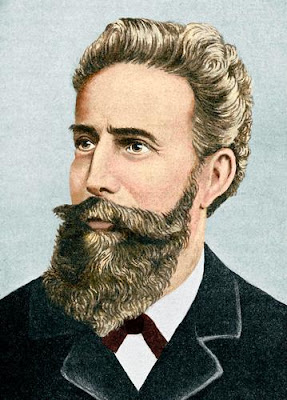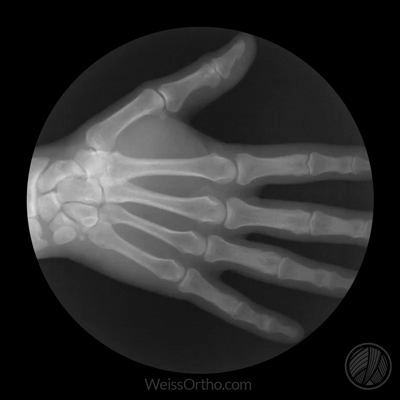Today (February 10, 1923) is the anniversary of Willem Röntgen, winner of the first Nobel Prize in Physics for his discovery of X-rays.

Wilhelm Conrad Röntgen was born on March 27,
1845, in Lennie, Bavaria, Germany, the only son of Friedrich Conrad Röntgen, a
textile merchant and businessman. His mother was Charlotte Consitas Froven from
Amsterdam. In 1848 they emigrated to Apeldoorn, the Netherlands for business.
Rontgen attended elementary school at a private school in Apeldoorn and from
1861 to 1863 at the Utrecht College of Technology. He was expelled from the
college for allegedly drawing a picture of a schoolteacher with disrespect to
him and for refusing to identify who he was. He was then unable to attend any
of the other Dutch Gymnasium schools. In 1865, he studied engineering at the
Federal Polytechnic College in Zurich. He received his doctorate in 1869 from
the University of Zurich. On July 7,1872 he married Anna Bertha Ludwig. Since
they had no children, they adopted and raised Anna's niece, Josephine Bertha
Ludwig.


In 1874 he joined Robert Kund in
the newly started field of physics at the University of Strasbourg, France. He
worked at the University of Wurttemberg in 1875, at the University of Okinawa,
at the University of Strasbourg in 1876, and at the University of Kaisen in
Germany from 1879 to 1885. In 1888 he was head of the Department of Physics at
the University of Wurttemberg. He joined the University of Munich in 1900 and
was the head of the physics department there until his death.


Studies were underway in several
laboratories on how electrification occurs in low-pressure gases. 1895 While
studying the various external effects of vacuum tube equipment he found a
barium platinocyanide coated card glowing near the negative rays generated.
Following that he did some more experiments in the darkroom and realized that
this glow was due to an invisible type of radiation. However, he named it X-rays
because of their unknown properties. And then the name stuck. He discovered this
on November 8, 1895. Two weeks later he had his first X-ray shot of his wife's
hand.

Röntgen published an original
article entitled A New Type of Rays on December 28, 1895. On January 5, 1896,
an Austrian newspaper Röntgen published his discovery of a new type of
radiation. He published three research papers on X-rays from 1895 to 1897.
Today Röntgen is known as the father of radiation medical testing. Röntgen
never claimed patents for his inventions. He was awarded the first Nobel Prize
in Physics in 1901. He donated the money he received from the Nobel Prize to
the University of Wuerzburg. In 1896 he received the Rumford Prize and the
Matteucci Medal.


Due to poverty during World War
I, Röntgen spent his final years in the village of Weideme, near Munich. Röntgen
died of bowel cancer on February 10, 1923. After his death, his personal and all
scientific equipment was destroyed at his will.


Today the Dutch Röntgen Museum is
located in his hometown of Remskit-Lenneprandken, 40 kilometres east of
Dsseldorf. In many languages, the name Rondken is used in response to the name
"X-ray" to refer to radiation therapy and its products.
"Randoken" in Japanese, "Randkeno" in Lithuanian,
"Rentken" in Serbian, Croatian and Hebrew, and "Rondken" in
Turkish. In November 2004, the element rhondconium was named after him.
Source By: Wikipedia.
Information: Dr. P. Ramesh, Assistant
Professor of Physics, Nehru Memorial College, Puthanampatti.
Get information like this
https://t.me/joinchat/jpqj3jQLN51kYTk9
Join Telegram Group.
https://chat.whatsapp.com/FisIzCe4Br2CRgxAiicUnf
Join WhatsApp Group
Thanks.
Also, Read
🛑👍 CSIR-NET Physics Materials and Problems
🛑📕 21 GB and Hundreds of Physics E-Books Collection.
🛑🛥️ How does an Electric Motor work? (DC Motor).
🛑🤹♂️ Science Academies' Summer Research Fellowship Programme for Students and Teachers 2022.
🛑🔌 How does a Transformer work - Working Principle electrical engineering.
🛑🎙️ Transistors Explained - How transistors work.
🛑🔥⚡ How Thermocouples Work - basic working principle.
🛑🔌 Voltage Explained - What is Voltage? Basic electricity potential difference
🛑🔌 What is CURRENT– electric current explained, electricity basics.



No comments:
Post a Comment